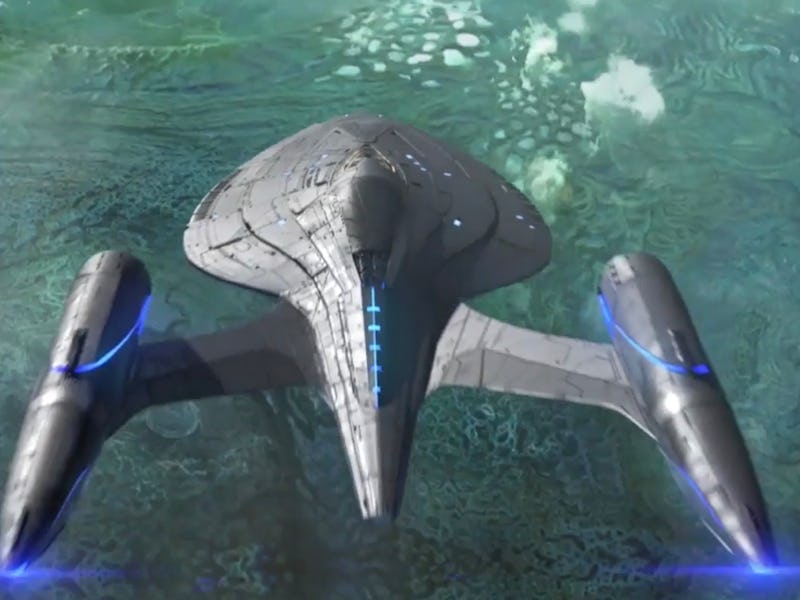
Beaming down is so over. In the Star Trek canon, the crew members of the various starships tend to avoid landing their starships, mainly because said ships are too big. Back in the ‘60s, that special effect would have been too expensive. But now, in Star Trek: Prodigy, one of the rarest sights in the Trek mythos— a starship landing on a planet — is suddenly common.
Here’s why the USS Protostar is shaking up canon and what it might mean. Spoilers ahead for Star Trek: Prodigy Episode 4, “Dreamcatcher.”
Why starships don’t usually land in Star Trek
The saucer of the Enterprise-D crash-landing in Star Trek: Generations.
In the Trek canon, the size of starships generally prohibits them from landing on the surface of planets on a regular basis. In canon, the idea is that starships are designed to exist in space, pretty much exclusively. In the 22nd century, before Starfleet perfected the transporter, heading down to a planet required a shuttle pod. And, well into the 23rd, 24th, and 32nd centuries of the Trek timeline, using smaller ships like shuttles, runabouts, or scoutships was generally the way to land on a planet if you didn’t want to beam down.
In real life, the reason why the classic USS Enterprise didn’t land on planets was mostly a matter of VFX economics. Having the ship land on each alien planet every week would have been hell on the physical models of the Enterprise, and early in the development of the series, Gene Roddenberry thought it seemed unrealistic anyway. The Original Series then created both the transporter and the shuttlecraft and demonstrated how the star trekkers could leave their ships. That is until Voyager.
Voyager (briefly) changed the starship landing game
The USS Voyager post-landing in “The 37’s.”
Starting with the Voyager episode “The 37’s,” it revealed that advanced — and smaller — starships built after 2371 had the ability to land and take-off from planets without any serious strain. Before this, if a Federation starship ended up in the atmosphere of a planet, it was likely a crash-landing, like when the entire saucer section of the USS Enterprise hit the trees in Star Trek Generations.
While some other governments — like the Klingons — used smaller ships like the famous Bird-of-Prey to land on planets all the time, the idea that an entire Federation ship would land was pretty much unheard of until Voyager.
In Voyager, this process only happened five other times on the show. When it was time to land Voyager, Captain Janeway ordered “Blue Alert.”
What the Protostar borrows from Picard
The La Sirena parked on the planet Coppelius in the Season 1 finale of Star Trek: Picard.
The relative size of the USS Protostar, at least in contrast with other Star Trek ships, is probably very, very small. So far, we haven’t seen any turbolifts, which seems to imply there are perhaps only three to four separate decks.
Like Captain Rois’ speed freighter, the La Sirena in Star Trek: Picard, the Protostar seems ultra-compact. In fact, the ship is so compact that even calling it a “starship” might be a misnomer. Then again, in Deep Space Nine, the souped-up shuttlecraft called “runabouts” were often referred to as “Federation Starships,” and those runabouts obviously landed all the time.
The difference is that runabouts — and the La Sirena — look like they can land. For lack of a better analogy, the La Sirena and the various shuttlecraft in Star Trek have a kind of Millennium Falcon vibe. You know they’re not tiny, but they’re also not so huge as to cause trouble when they touchdown.
The Protostar on the surface of an alien world.
But the Protostar looks more like Voyager. Because there’s a hologram of Janeway aboard, and the ship is in the Delta Quadrant, it feels more like Voyager, too. Although this hasn’t been established in the show yet, it feels possible the Protostar might not even use transporters as a standard operating procedure. When Dal and the crew decide to land on the M-Class planet in “Dreamcatcher,” Hologram Janeway doesn’t even suggest they beam down. Instead, landing the ship is viewed as not only the best option but also the only option.
And it’s right there that the Protostar represents something new for the Star Trek canon. Even if the ship has beaming capability, the fact that the default is to land the ship says something interesting about the ship’s design. Maybe it’s not as super-advanced as we think. Instead, perhaps the Protostar has some things about it that are intentionally retrograde. Space travel is all well and good, but if the starships are too unwieldy to hang out on planets for long periods of time, then what’s the point of boldly going at all?
Star Trek: Prodigy will air its midseason finale on November 18 on Paramount+.